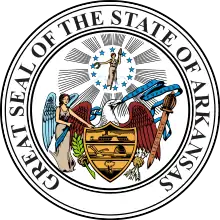Lawrence County, Arkansas
Lawrence County is a county located in the U.S. state of Arkansas. As of the 2010 census, the population was 17,415.[1] The county seat is Walnut Ridge.[2] Lawrence County is Arkansas's second county, formed on January 15, 1815, and named for Captain James Lawrence who fought in the War of 1812.[3] It is an alcohol prohibition or dry county.
Lawrence County | |
|---|---|
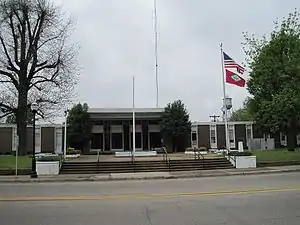 Lawrence County Courthouse | |
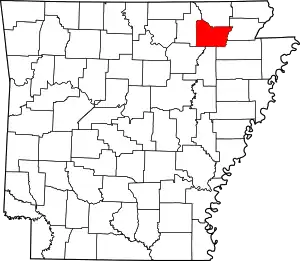 Location within the U.S. state of Arkansas | |
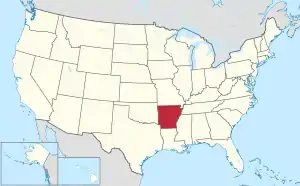 Arkansas's location within the U.S. | |
| Coordinates: 36°01′50″N 91°06′47″W | |
| Country | |
| State | |
| Founded | January 15, 1815 |
| Named for | James Lawrence |
| Seat | Walnut Ridge |
| Largest city | Walnut Ridge |
| Area | |
| • Total | 592 sq mi (1,530 km2) |
| • Land | 588 sq mi (1,520 km2) |
| • Water | 4.7 sq mi (12 km2) 0.8%% |
| Population (2010) | |
| • Total | 17,415 |
| • Estimate (2019) | 16,406 |
| • Density | 29/sq mi (11/km2) |
| Time zone | UTC−6 (Central) |
| • Summer (DST) | UTC−5 (CDT) |
| Congressional district | 1st |
| Website | www |
Geography
According to the U.S. Census Bureau, the county has a total area of 592 square miles (1,530 km2), of which 588 square miles (1,520 km2) is land and 4.7 square miles (12 km2) (0.8%) is water.[4]
Major highways
.svg.png.webp) Future I-57
Future I-57.svg.png.webp) US 62
US 62.svg.png.webp) US 63
US 63 U.S. Route 63B
U.S. Route 63B U.S. Route 67B
U.S. Route 67B.svg.png.webp) US 67
US 67 U.S. Route 412
U.S. Route 412 Highway 25
Highway 25 Highway 34
Highway 34 Highway 90
Highway 90 Highway 91
Highway 91 Highway 115
Highway 115 Highway 117
Highway 117 Highway 117 Spur
Highway 117 Spur Highway 228
Highway 228 Highway 230
Highway 230 Highway 361
Highway 361
Adjacent counties
- Randolph County (north)
- Greene County (east)
- Craighead County (southeast)
- Jackson County (south)
- Independence County (southwest)
- Sharp County (west)
Demographics
| Historical population | |||
|---|---|---|---|
| Census | Pop. | %± | |
| 1830 | 2,806 | — | |
| 1840 | 2,835 | 1.0% | |
| 1850 | 5,274 | 86.0% | |
| 1860 | 9,372 | 77.7% | |
| 1870 | 5,981 | −36.2% | |
| 1880 | 8,782 | 46.8% | |
| 1890 | 12,984 | 47.8% | |
| 1900 | 16,491 | 27.0% | |
| 1910 | 20,001 | 21.3% | |
| 1920 | 22,098 | 10.5% | |
| 1930 | 21,663 | −2.0% | |
| 1940 | 22,651 | 4.6% | |
| 1950 | 21,303 | −6.0% | |
| 1960 | 17,267 | −18.9% | |
| 1970 | 16,320 | −5.5% | |
| 1980 | 18,447 | 13.0% | |
| 1990 | 17,457 | −5.4% | |
| 2000 | 17,774 | 1.8% | |
| 2010 | 17,415 | −2.0% | |
| 2019 (est.) | 16,406 | [5] | −5.8% |
| U.S. Decennial Census[6] 1790–1960[7] 1900–1990[8] 1990–2000[9] 2010–2016[1] | |||

As of the 2000 census,[11] there were 17,774 people, 7,108 households, and 5,011 families residing in the county. The population density was 30 people per square mile (12/km2). There were 8,085 housing units at an average density of 14 per square mile (5/km2). The racial makeup of the county was 97.78% White, 0.44% Black or African American, 0.57% Native American, 0.05% Asian, 0.01% Pacific Islander, 0.12% from other races, and 1.02% from two or more races. 0.68% of the population were Hispanic or Latino of any race.
There were 7,108 households, out of which 30.80% had children under the age of 18 living with them, 57.70% were married couples living together, 9.60% had a female householder with no husband present, and 29.50% were non-families. 26.70% of all households were made up of individuals, and 14.20% had someone living alone who was 65 years of age or older. The average household size was 2.42 and the average family size was 2.92.
In the county, the population was spread out, with 24.00% under the age of 18, 9.60% from 18 to 24, 25.90% from 25 to 44, 23.20% from 45 to 64, and 17.40% who were 65 years of age or older. The median age was 38 years. For every 100 females there were 93.60 males. For every 100 females age 18 and over, there were 89.40 males.
The median income for a household in the county was $27,139, and the median income for a family was $32,163. Males had a median income of $26,288 versus $18,518 for females. The per capita income for the county was $13,785. About 13.90% of families and 18.40% of the population were below the poverty line, including 25.50% of those under age 18 and 20.10% of those age 65 or over.
Government
Like almost all of Arkansas and the rural South, the 21st century has seen Lawrence County make a hard turn to the Republican Party after supporting Democrats throughout its history; the move is likely due to persistent racial and cultural agitation by the Democratic Party, which has not gone over well in Appalachian and rural Southern areas. John Kerry was the last Democrat to win the county in a presidential election, in 2004. Further elections has only seen sharper turns to the right, first at the presidential level and increasingly for other contested seats, to the point where this county, and Arkansas as a whole, is very Republican today.
| Year | GOP | Dem | Others |
|---|---|---|---|
| 2016 | 71.49% 4,064 | 22.22% 1,263 | 6.30% 358 |
| 2012 | 63.83% 3,536 | 32.27% 1,788 | 3.90% 216 |
| 2008 | 57.58% 3,357 | 36.67% 2,138 | 5.75% 335 |
| 2004 | 44.61% 2,951 | 53.58% 3,544 | 1.81% 120 |
| 2000 | 43.48% 2,626 | 53.89% 3,255 | 2.63% 159 |
| 1996 | 29.69% 1,823 | 59.47% 3,652 | 10.85% 666 |
| 1992 | 30.65% 2,124 | 59.84% 4,146 | 9.51% 659 |
| 1988 | 49.91% 3,205 | 49.51% 3,179 | 0.58% 37 |
| 1984 | 60.50% 4,039 | 38.86% 2,594 | 0.64% 43 |
| 1980 | 46.60% 3,245 | 50.94% 3,547 | 2.46% 171 |
| 1976 | 24.82% 1,708 | 75.08% 5,167 | 0.10% 7 |
| 1972 | 69.45% 3,981 | 30.55% 1,751 | 0.00% 0 |
| 1968 | 28.77% 1,788 | 25.96% 1,613 | 45.27% 2,813 |
| 1964 | 36.35% 2,013 | 63.16% 3,498 | 0.49% 27 |
| 1960 | 44.28% 1,800 | 51.02% 2,074 | 4.70% 191 |
| 1956 | 40.12% 1,584 | 58.33% 2,303 | 1.55% 61 |
| 1952 | 40.84% 1,570 | 57.39% 2,206 | 1.77% 68 |
| 1948 | 18.60% 497 | 74.89% 2,001 | 6.51% 174 |
| 1944 | 33.83% 927 | 66.06% 1,810 | 0.11% 3 |
| 1940 | 25.36% 852 | 73.93% 2,484 | 0.71% 24 |
| 1936 | 16.91% 457 | 82.50% 2,230 | 0.59% 16 |
| 1932 | 8.58% 293 | 89.54% 3,056 | 1.88% 64 |
| 1928 | 39.03% 774 | 60.72% 1,204 | 0.25% 5 |
| 1924 | 23.18% 261 | 61.19% 689 | 15.63% 176 |
| 1920 | 28.72% 699 | 69.27% 1,686 | 2.01% 49 |
| 1916 | 14.87% 298 | 85.13% 1,706 | 0.00% 0 |
| 1912 | 15.15% 218 | 64.56% 929 | 20.30% 292 |
| 1908 | 31.79% 583 | 64.78% 1,188 | 3.44% 63 |
| 1904 | 42.41% 534 | 53.38% 672 | 4.21% 53 |
| 1900 | 32.96% 476 | 66.34% 958 | 0.69% 10 |
| 1896 | 16.42% 337 | 81.78% 1,679 | 1.80% 37 |
Education
Public education is available from four school districts:
Communities
Cities
- Black Rock
- Hoxie
- Walnut Ridge (county seat)
Towns
Townships
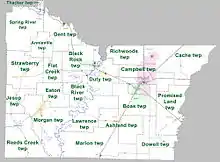
Townships in Arkansas are the divisions of a county. Each township includes unincorporated areas; some may have incorporated cities or towns within part of their boundaries. Arkansas townships have limited purposes in modern times. However, the United States Census does list Arkansas population based on townships (sometimes referred to as "county subdivisions" or "minor civil divisions"). Townships are also of value for historical purposes in terms of genealogical research. Each town or city is within one or more townships in an Arkansas county based on census maps and publications. The townships of Lawrence County are listed below; listed in parentheses are the cities, towns, and/or census-designated places that are fully or partially inside the township. [13][14]
- Annieville
- Ashland (Minturn)
- Black River (Powhatan)
- Black Rock (most of Black Rock)
- Boas (Hoxie, part of Walnut Ridge)
- Cache
- Campbell (College City, most of Walnut Ridge)
- Dent (Imboden)
- Duty (Portia, small part of Black Rock)
- Eaton
- Flat Creek
- Jesup
- Lawrence
- Marion (Alicia)
- Morgan (Lynn)
- Promised Land (Sedgwick)
- Reeds Creek (Strawberry)
- Richwoods (small part of Walnut Ridge)
- Spring River (small part of Ravenden)
- Strawberry (Smithville)
- Thacker (most of Ravenden)
See also
- List of lakes in Lawrence County, Arkansas
- National Register of Historic Places listings in Lawrence County, Arkansas
References
- "State & County QuickFacts". United States Census Bureau. Archived from the original on June 7, 2011. Retrieved May 23, 2014.
- "Find a County". National Association of Counties. Retrieved 2011-06-07.
- Hempstead, Fay (1890). A Pictorial History of Arkansas: From Earliest Times to the Year 1890. Southern Historical Press. p. 833.
- "2010 Census Gazetteer Files". United States Census Bureau. August 22, 2012. Retrieved August 27, 2015.
- "Population and Housing Unit Estimates". Retrieved September 28, 2019.
- "U.S. Decennial Census". United States Census Bureau. Retrieved August 27, 2015.
- "Historical Census Browser". University of Virginia Library. Retrieved August 27, 2015.
- Forstall, Richard L., ed. (March 27, 1995). "Population of Counties by Decennial Census: 1900 to 1990". United States Census Bureau. Retrieved August 27, 2015.
- "Census 2000 PHC-T-4. Ranking Tables for Counties: 1990 and 2000" (PDF). United States Census Bureau. April 2, 2001. Retrieved August 27, 2015.
- Based on 2000 census data
- "U.S. Census website". United States Census Bureau. Retrieved 2011-05-14.
- "Dave Leip's Atlas of U.S. Presidential Elections". Retrieved November 18, 2016.
- 2011 Boundary and Annexation Survey (BAS): Lawrence County, AR (PDF) (Map). U. S. Census Bureau. Archived from the original (PDF) on 2012-10-19. Retrieved 2011-08-07.
- "Arkansas: 2010 Census Block Maps - County Subdivision". United States Census Bureau. Archived from the original on May 28, 2014. Retrieved May 29, 2014.
